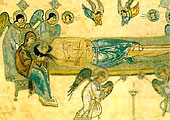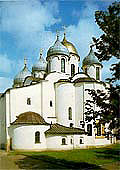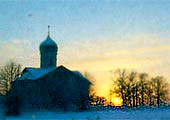
© Love Me
 Novgorod is one of the most ancient cities of Russia. It is located in Northwest Russia,near the site where the
Volkhov river takes its waters from Lake Ilmen. Novgrorod emerged as a political center of Slavic and
Fino-Ugric tribes in the mid-9th century, while as a town it was formed in the middle of the 10th century.
Novgorod is one of the most ancient cities of Russia. It is located in Northwest Russia,near the site where the
Volkhov river takes its waters from Lake Ilmen. Novgrorod emerged as a political center of Slavic and
Fino-Ugric tribes in the mid-9th century, while as a town it was formed in the middle of the 10th century.
The adoption of Christianity at the close of the tenth century turned Novgorod into a powerful ecclesiastical center.
The efforts of Novgorod Bishops in spreading and promoting the Orthodoxy were given high credit in
the mid-12th century when they were elevated to the ranks of Archbishops. This in turn made the
 Bishops Chair of Novgorod the most powerful in the Russian Orthodoxy
Bishops Chair of Novgorod the most powerful in the Russian Orthodoxy
Throughout many centuries, Novgorod was a political center of vast territories stretching up from the
Baltic lands and Finland in the West to the northern Urals in the East. It was also one of the greatest
international trade centers on theBaltic-Volga commercial route that tied northern Europe with Asia
as early as the mid 8th century.
Novgorod is the cradle of Russian republican and democratic traditions. In the course of over 600 years
(up till 1478) all vital decisions on life and foreign policy in Russia were taken by the "veche" - an ancient
parliament comprising the representatives of the town's aristocratic families. During crucial times of
Novgorod history, all people took part in the veche.
The republic's special political structure, spiritual freedom and territorial
independence were highly favorable in evolving culture and art.
 Novgorod was one of Russia's major centers of literacy and book production. As far back as 1030
(by the will of the great Prince Yaroslav The Wise), Novgorod created the first school to train three hundred children at a time.
Novgorod was one of Russia's major centers of literacy and book production. As far back as 1030
(by the will of the great Prince Yaroslav The Wise), Novgorod created the first school to train three hundred children at a time.
Medieval Novgorod was one of the greatest art centers of Europe. Its architectural traditions, school of icon-painting,
jeweler's and decorative applied art became famous all over the world.
The open-air architectural-ethnographic museum Vitoslavlitsy provides a whole complex of genuine folk
wooden architecture, including ancient churches of the 16th - 18th centuries and peasant houses
of the 19th - early 20th centuries. There are also exhibitions of folk art and everyday life items
of Novgorod peasants from the same period.
Visit the historical city of Novgorod and experience all it has to offer!